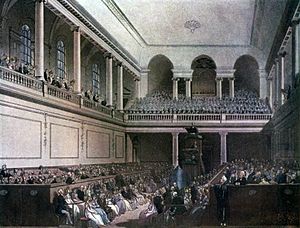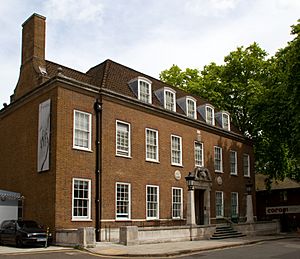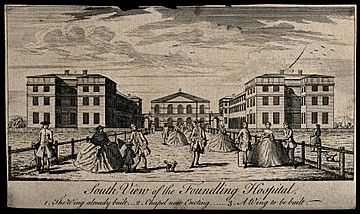Foundling Hospital Anthem facts for kids
Quick facts for kids Foundling Hospital Anthem |
|
|---|---|
| by George Frideric Handel | |

The Foundling Hospital Chapel, where Handel's anthem was first performed
|
|
| Full title | Blessed are they that considereth the poor |
| Catalogue | HWV 268 |
| Period | Baroque |
| Genre | Choral anthem |
| Text | adapted from the King James Bible |
| Language | English |
| Movements | 4 |
| Premiere | |
| Date | 27 May 1749 |
| Location | The Foundling Hospital Chapel, Bloomsbury, London |
| Conductor | George Frideric Handel |
| Performers | Children of the Chapel Royal |
The Foundling Hospital Anthem (HWV 268) is a special song for choirs. It was written by the famous composer George Frideric Handel in 1749. Its full name is "Blessed are they that considereth the poor." Handel created it for the Foundling Hospital in London, a place that cared for children.
This anthem was first performed in the hospital's chapel. Handel made two versions: one just for a choir, and another for a choir with solo singers. It was one of the last pieces of English church music Handel wrote, composed about 10 years before he passed away.
Contents
What Was the Foundling Hospital?
The Foundling Hospital was a charity started in 1739. It was founded by a kind sea captain named Thomas Coram. His goal was to provide a home and education for children who had been abandoned or orphaned.
King George II officially approved the hospital. Many important people from high society and the arts supported it. The painter William Hogarth was one of its first leaders. Thanks to him, the Foundling Hospital became a very popular charity. Many famous artists helped out. They even showed their paintings at the hospital, making what might have been Britain's first public art gallery!
Handel was asked to put on a special concert at the hospital chapel to raise money. For this event, he composed the Foundling Hospital Anthem.
The First Performance
The Foundling Hospital Anthem was first heard at a concert on May 27, 1749. It was held at midday in the hospital chapel. The chapel wasn't fully finished yet; it didn't even have glass in the windows!
The Prince and Princess of Wales attended the performance. The concert started with Handel's Anthem for the Peace. Then, parts of his oratorio Solomon were played. Finally, the Foundling Hospital Anthem was performed.
The anthem ended with the famous "Hallelujah" chorus from Handel's Messiah. At that time, Messiah wasn't as well-known as it is today. It's thought that royalty first stood up for the "Hallelujah" chorus at this concert. This started a long tradition that continues even now. The concert was a huge success for both Handel and the hospital.
This fundraising concert began a long friendship between Handel and the Foundling Hospital. He later gave a pipe organ to the new chapel. In 1750, he held another benefit concert there, performing Messiah. So many people wanted to hear it that Handel had to do a second show two weeks later!
The Foundling Hospital was very grateful. They made Handel a leader of the charity. An annual tradition began: performing Messiah every Easter in the hospital chapel. This helped Messiah become incredibly popular in Britain. Handel attended every performance until he died in 1759. After his death, a memorial concert was held in his honor. The Foundling Hospital Anthem was performed again at this event.
How the Anthem Was Made
The Foundling Hospital Anthem uses music from other works by Handel. For example, it includes parts from his Funeral Anthem for Queen Caroline (1737). It also has a chorus that was removed from his opera Susanna (1748). Most famously, it ends with the "Hallelujah" chorus from Messiah.
Handel's first version of the anthem was just for a choir. He wrote it for the fundraising concert in May 1749. He then made a second version, probably in 1751. This was for the official opening of the Foundling Hospital Chapel.
The children living at the Foundling Hospital did not sing in these performances. Instead, the choir was made up of the Children of the Chapel Royal. For the revised version, the solo singers included John Beard (tenor), Gaetano Guadagni (a castrato singer), and two young boy trebles from the Chapel Royal.
It's not fully known why Handel chose to end the anthem with the "Hallelujah" chorus. The anthem is about being kind to the poor. Handel might have wanted to connect this idea to the idea of "the Kingdom of this world" becoming "the kingdom of our Lord." This is a concept from Jesus' Parable of The Sheep and the Goats in the Bible. Or, Handel might have simply wanted a powerful and exciting ending for the anthem!
The Words of the Anthem
The anthem begins with words taken from Psalm 41 and the Book of Job in the Bible. The famous "Hallelujah" chorus uses words from the Book of Revelation.
Blessed are they that considereth the poor and needy:
the Lord will deliver them in time of trouble,
the Lord preserve them and comfort them.
They deliver the poor that crieth, the fatherless
and him that hath none to help him.
The Lord will comfort them.
O God, who from the suckling’s mouth
ordaineth early praise,
of such as worship Thee in truth
accept the humble lays.
The charitables shall be had in everlasting remembrance
and the good will shine as the brightness of the firmament.
Comfort them, O Lord, when they are sick:
make thou their bed in sickness.
Keep them alive, let them be blessed upon the earth
and not deliver them unto their foes.
Hallelujah!
The Kingdom of this world
is become the kingdom of our Lord
and of His Christ,
and He shall reign forever and ever.
Hallelujah!
Lasting Impact

Handel's concerts for the Foundling Hospital were very successful. They raised almost £7,000, which would be over £1 million today! His help is still remembered.
The Foundling Hospital moved in 1935 to a new building in Berkhamsted, Hertfordshire. The old building in Bloomsbury, including the chapel, was torn down. Today, a children's park called Coram's Fields is on that site. The hospital eventually closed in 1955. The Berkhamsted building became a secondary school called Ashlyns School.
The charity that Handel supported still exists today! It's now called the Thomas Coram Foundation for Children, or simply Coram. The original musical scores of the Foundling Hospital Anthem and Messiah that Handel gave to the hospital are now on display. You can see them at the Foundling Museum in London. Handel's Anthem is also performed every year in February to celebrate his birthday.
The tradition of performing Messiah for charity continues with "Scratch Messiah" concerts. In these events, the public can join in singing the choruses. These concerts often raise money for good causes. They are a popular tradition of Christmas music in Britain and America, dating back to the 1820s.


